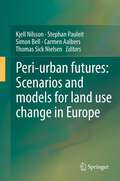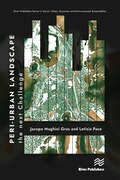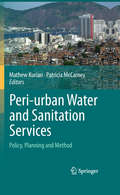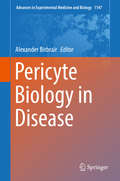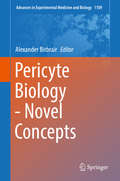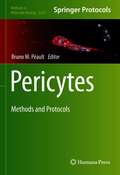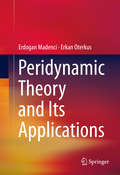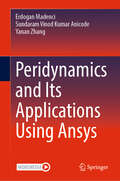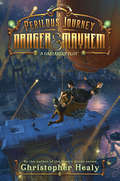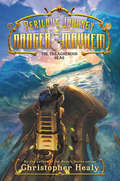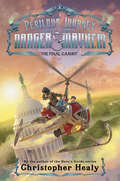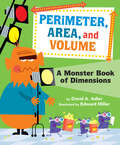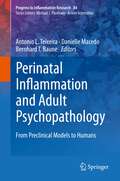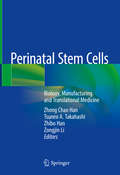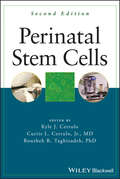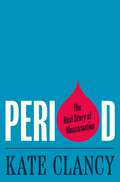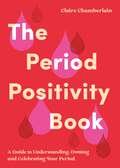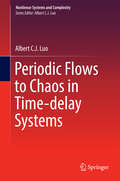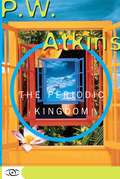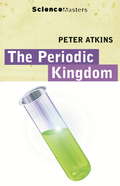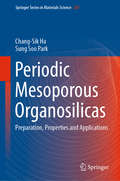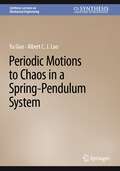- Table View
- List View
The Perfume Lover: A Personal History of Scent
by Denyse BeaulieuThe Perfume Lover is a candid personal account of the process of composing a fragrance, filled with sensual scent descriptions, sexy tidbits, and historical vignettes.What if the most beautiful night in your life inspired a perfume? When Denyse Beaulieu was growing up near Montreal, perfume was forbidden in her house, spurring a childhood curiosity that became an intellectual and sensual passion. It is this passion she pursued all the way to Paris, where she now lives, and which led her to become a respected fragrance writer. But little did she know that it would also lead her to achieve a perfume lover's wildest dream: When Denyse tells famous perfumer Betrand Duchaufour at L'Artisan Parfumeur of a sensual night spent in Seville under a blossoming orange tree, wrapped in the arms of a beautiful man, the story stirs his imagination and together they create a scent that captures the essence of that night. As their unique creative collaboration unfolds, the perfume-in-progress conjures intimate memories, leading Beaulieu to make sense of her life through scents. Throughout the book, she weaves the evocative history of perfumery into her personal journey, in an intensely passionate voice: the masters and the masterpieces, the myths and the myth-busting, down to the molecular mysteries that weld our flesh to flowers.Now, just to set your nostrils aquiver: Séville à l'aube is an orange blossom oriental with zesty, green and balsamic effects, with notes of petitgrain, petitgrain citronnier, orange blossom, beeswax, incense, and lavender, and is now available at fragrance outlets in the U.S.
Perfusion Cell Culture Processes for Biopharmaceuticals: Process Development, Design, and Scale-up (Cambridge Series in Chemical Engineering)
by Massimo Morbidelli Moritz Wolf Jean-Marc BielserMaster the design and operation of perfusion cell cultures with this authoritative reference. Discover the current state-of-the-art in the design and operation of continuous bioreactors, with emphasis on mammalian cell cultures for producing therapeutic proteins. Topics include the current market for recombinant therapeutic proteins, current industry challenges and the potential contribution of continuous manufacturing. Provides coverage of every step of process development and reactor operation, including small scale screening to lab-scale and scale-up to manufacturing scale. Illustrated through real-life case studies, this is a perfect resource for groups active in the cell culture field, as well as graduate students in areas such as chemical engineering, biotechnology, chemistry and biology, and to those in the pharmaceutical industry, particularly biopharma, biotechnology and food or agro industry.
Peri-urban futures: Scenarios and models for land use change in Europe
by Carmen Aalbers Kjell Nilsson Simon Bell Stephan Pauleit Thomas A. Sick NielsenPresently, peri-urbanisation is one of the most pervasive processes of land use change in Europe with strong impacts on both the environment and quality of life. It is a matter of great urgency to determine strategies and tools in support of sustainable development. The book synthesizes the results of PLUREL, a large European Commission funded research project (2007-2010). Tools and strategies of PLUREL address main challenges of managing land use in peri-urban areas. These results are presented and illustrated by means of 7 case studies which are at the core of the book. This volume presents a novel, future oriented approach to the planning and management of peri-urban areas with a main focus on scenarios and sustainability impact analysis. The research is unique in that it focuses on the future by linking quantitative scenario modeling and sustainability impact analysis with qualitative and in-depth analysis of regional strategies, as well as including a study at European level with case study work also involving a Chinese case study.
Peri-urban Landscape: The Next Challenge (River Publishers Series in Social, Urban, Economic and Environmental Sustainability)
by Jacopo Mughini Gras Letizia PaceThis book underlines the importance of establishing, in the planning and urban policies oriented towards sustainability, a relationship between the urban expansion – observed in its different forms and dynamics – and the ability of soil and landscape to support agricultural productivity and interface processes. This is the development of a specific investigation theme linked to the problem of soil degradation and peri-urban lands allows a valuable re-interpretation in the field of landscape studies. This book queries the value of the "rural" around a city, in a multidisciplinary perspective encompassing land transformations, good practices, and urban planning trends.Land transformations are at the center of analysis and discussions on the management, planning, and design of the landscape everywhere. This topic is particularly appropriate for European landscapes where land changes are often associated with the degradation of rural and natural areas. This issue represents a crucial point within the framework of the ecological transition towards a truly sustainable society and economy, as established by the European Union.This book is the result of detailed bibliographic research, of in-depth historical research on the most recent challenges and topics of greatest interest in the field of urban studies. Original landscape transformations analyses were performed, introducing also some practical cases, considered relevant contributions in spatial planning.
Peri-urban Water and Sanitation Services
by Mathew Kurian Patricia MccarneyMore than 2.6 billion people in the developing world lack access to safe water and sanitation service. The Millennium Development Goal's (MDG) target is to halve the number of people without access to a sustainable source of water supply and connection to a sewer network by 2015. That target is unlikely to be met. If there is anything that can be learnt from European experience it is that institutional reform occurs incrementally when politically enfranchised urban populations perceive a threat to their material well-being due to contamination of water sources.
Pericyte Biology in Disease (Advances in Experimental Medicine and Biology #1147)
by Alexander BirbrairThis volume explores pericytes' roles under distinct pathological conditions, ranging from tumors, ALS, Alzheimer’s disease, Multiple Sclerosis, stroke, diabetes, atherosclerosis, muscular dystrophies and more. Together with its companion volumes Pericyte Biology in Different Organs and Pericyte Biology – Novel Concepts, Pericyte Biology in Disease presents a comprehensive update on the latest information and most novel functions attributed to pericytes. To those researchers newer to this area, it will be useful to have the background information on these cells' unique history. It will be invaluable for both advanced cell biology students as well as researchers in cell biology, stem cell biology and clinicians involved with these specific diseases.
Pericyte Biology - Novel Concepts (Advances in Experimental Medicine and Biology #1109)
by Alexander BirbrairThis volume explores novel concepts of pericyte biology. The present book is an attempt to describe the most recent developments in the area of pericyte biology which is one of the emergent hot topics in the field of molecular and cellular biology today. Here, we present a selected collection of detailed chapters on what we know so far about the pericytes. Together with its companion volumes Pericyte Biology in Different Organs and Pericyte Biology in Disease, Pericyte Biology - Novel Concepts presents a comprehensive update on the latest information and most novel functions attributed to pericytes. To those researchers newer to this area, it will be useful to have the background information on these cells' unique history. It will be invaluable for both advanced cell biology students as well as researchers in cell biology, stem cells and researchers or clinicians involved with specific diseases.
Pericytes: Methods and Protocols (Methods in Molecular Biology #2235)
by Bruno M. PéaultThis volume explores the techniques used to study human and animal pericytes. Chapters in this volume cover a range of topics such as pericyte dissociation from tissues, and analysis by immunohistochemistry and flow cytometry; avian chimaeras to investigate the embryonic development of cell lineage; pericyte purification by fluorescence activated cell sorting and ensuing culture; tissue turnover and regeneration; and the dynamic study of pericyte involvement in cancer dissemination, in situ, and in culture. Written in the highly successful Methods in Molecular Biology series format, chapters include introductions to their respective topics, lists of the necessary materials and reagents, step-by-step, readily reproducible laboratory protocols, and tips on troubleshooting and avoiding known pitfalls.Authoritative and practical, Pericytes: Methods and Protocols is a valuable resource that helps researchers define the biologic identity, functions, and potentials of a cell lineage of increasing interest and therapeutic significance.
Peridynamic Theory and Its Applications
by Erdogan Madenci Erkan OterkusThis book presents the peridynamic theory, which provides the capability for improved modeling of progressive failure in materials and structures, and paves the way for addressing multi-physics and multi-scale problems. The book provides students and researchers with a theoretical and practical knowledge of the peridynamic theory and the skills required to analyze engineering problems. The text may be used in courses such as Multi-physics and Multi-scale Analysis, Nonlocal Computational Mechanics, and Computational Damage Prediction. Sample algorithms for the solution of benchmark problems are available so that the reader can modify these algorithms, and develop their own solution algorithms for specific problems. Students and researchers will find this book an essential and invaluable reference on the topic.
Peridynamics and Its Applications Using Ansys
by Yanan Zhang Erdogan Madenci Sundaram Vinod AnicodeThis book introduces a unified implementation of bond- and state-based peridynamic theory (PD) within a commercial finite element framework, Ansys, utilizing its native elements. It details the implementation of the PD theory and its integration with traditional finite elements. The primary objective is to equip students, researchers, and practicing engineers with both theoretical and practical knowledge of the PD theory, along with the skills necessary for analyzing engineering problems using Ansys. The book demonstrates that, unlike the conventional finite element method (FEM), the PD theory is highly suitable for progressive failure analysis, the multi-scale analysis of materials involving fracture and failure, and multi-physics analysis, including electromigration, corrosion, and electrodeposition. Additionally, it provides a step-by-step illustration of the specific procedures in the pre-processing, solution, and post-processing phases of the analysis through the Graphical User Interface (GUI) for various applications. The book is designed to be introductory and self-contained, minimizing the need for additional reference material.
A Perilous Journey of Danger and Mayhem #1: A Dastardly Plot (Perilous Journey of Danger and Mayhem #1)
by Christopher HealyA rip-roaring, hilarious alternate-history adventure starring the world’s most famous inventors—and its most forgotten. From the author of the beloved Hero’s Guide series, Christopher Healy.It's 1883—the Age of Invention! A time when great men like Thomas Edison, Alexander Graham Bell, Nicola Tesla, and George Eastman work to turn the country into a land of limitless opportunity.And it all happens at the world famous Inventor’s Guild headquarters in New York City—a place where a great idea, a lot of hard work, and a little bit of luck can find you rubbing elbows with these gods of industry who will usher humanity into the future.Unless, of course, you’re a woman.Molly Pepper, daughter of brilliant but unknown inventor Cassandra Pepper, lives with her mother in New York. By day, they make ends meet running a pickle shop; but by night, they toil and dream of Cassandra taking her place among the most famous inventors in America.In an attempt to find a way to exhibit Cass’s work at the World’s Fair, they break into the Inventor's Guild, where they discover a mysterious plot to destroy New York.The evidence points to the involvement of one of the world’s most famous inventors, and now it’s up to Molly, Cassandra, and a shop hand named Emmett Lee to uncover the truth—even if no one will ever know it was they who did it.“Christopher Healy, author of the Hero’s Guide series, knows how to tell a good story. He’s done it again with the adventures of a determined girl named Molly Pepper.”—Brightly, Best Middle Grade Books of Fall 2018
A Perilous Journey of Danger and Mayhem #2: The Treacherous Seas (Perilous Journey of Danger and Mayhem #2)
by Christopher HealyThe second book in the new adventure trilogy from the beloved author of The Hero's Guide to Saving Your Kingdom.It's 1883—only a few months after Molly Pepper; her mother, Cassandra; and her friend, Emmett, saved New York from an attack by the megalomaniacal Ambrose Rector while managing to preserve the reputations of Alexander Graham Bell and Thomas Edison, whose technology was manipulated in Rector’s scheme. Their selfless heroism will finally earn them a place in the Inventors’ Guild, alongside the greatest minds of their generation.Unless, of course, no one knows that they did any of that.Left with nothing but empty promises and a struggling pickle shop after the government chooses to cover up the crisis, Molly, Cassandra, and Emmett have no idea where to turn—until they learn of a daring expedition to the South Pole, where an meteorite of mysterious power is embedded, and where Emmett’s father, explorer and ship captain Wendell Lee, disappeared years ago. With the fate of the world hanging in the balance, our heroes commandeer an experimental seacraft to make their play on the pole. But the trip is more treacherous than they realize, and there’s no guarantee that they will return successful—if they even return at all.
A Perilous Journey of Danger and Mayhem #3: The Final Gambit (Perilous Journey of Danger and Mayhem #3)
by Christopher HealyThe thrilling conclusion to Christopher Healy's funny, action-packed, acclaimed alt-history adventure!It is 1884, and Molly and Cassandra Pepper, Emmett Lee, and Emmett’s long-lost father are sailing back to New York following their death-defying adventure in Antarctica. Having discovered a subterranean world at the South Pole while saving the world from certain doom once again, surely their accomplishments will finally earn them the recognition they deserve.Unless, of course . . . well, you know by now.And so do the Peppers and Lees. They’re used to having their deeds covered up by the government in order to protect powerful men, and frankly, they’re sick of it. And when their return to New York doesn’t go the way they’d planned, they decide that maybe it’s best to go into hiding and accept that, perhaps, the forces aligned against them are just too great.As the 1884 presidential election approaches, however, our heroes discover a plot against leading candidate Thomas Edison that only they can stop. It’ll be up to them to decide whether to come out of hiding, make the perilous journey to Washington, DC, and do the right thing one last time. Even if it means risking everything they have left.
Perimeter, Area, and Volume: A Monster Book of Dimensions
by David A. AdlerGrab your jumbo popcorn—you're invited to the premiere of a 3-D movie, all about those three dimensions!Trusted math picture book duo David A. Adler and Ed Miller tackle the differences between two- and three-dimensional objects in their signature bright and kid-friendly way. Explaining length, width, and height-- and all the different ways we represent those figures-- Adler shows how changing the dimensions of an object affects its size. . . . with some help from a cast of funny, friendly movie monsters. Explaining key vocabulary in simple text and offering numerous concrete examples and sample math problems with included solutions, Perimeter, Area, and Volume is a perfect introduction to two- and three-dimensional geometry. The star-studded cast of monsters will help you calculate the perimeter of the set, the area of the movie screen, and the volume of your box of popcorn.Learning about dimensions has never been so entertaining!
Perinatal Biochemistry
by Emilio Herrera Robert H. KnoppIntrauterine development and birth constitute an uninterrupted sequence of events that have a molecular physiologic background. Perinatal Biochemistry presents a comprehensive review of this subject. Specific topics addressed include maternal metabolism during pregnancy, maternal insulin resistance, embryonic and fetal metabolism and fuel consumption, the fetal pancreas, growth factors, brain metabolism, and biochemical adaptations to early extrauterine life. The book will be useful to biochemists and physiologists interested in perinatology; clinicians working in areas related to maternal health, gestational development, and delivery; gynecologists, neonatologists; pediatricians; endocrinologists; and internists.
Perinatal Inflammation and Adult Psychopathology: From Preclinical Models to Humans (Progress in Inflammation Research #84)
by Bernhard T. Baune Antonio L. Teixeira Danielle MacedoPerinatal psychiatry is an emerging field that investigates the role of perinatal events – for example pregnancy complications and infections – in the development of neuropsychiatric conditions, such as schizophrenia and mood disorders. Among the implicated pathological mechanisms, perinatal-induced inflammation seems to play a major role and is being considered as a potential target for therapeutic intervention. Bringing together various approaches in the field (preclinical and clinical, epidemiological, immunological and genetic methods), the book discusses the available evidence, the putative mechanisms and the challenges ahead.
Perinatal Stem Cells: Biology, Manufacturing and Translational Medicine
by Zhong Chao Han Tsuneo A. Takahashi Zhibo Han Zongjin LiThis book provides a comprehensive introduction to various types of perinatal stem cells. Given their unique regenerative abilities, stem cells offer a promising avenue in the treatment of degenerative diseases or injury. Currently, the limitations of postnatal cell sources and expanding efficiency may limit autologous stem cell therapies. Although embryonic stem cells (ESCs) and induced pluripotent stem cells (iPSCs) can be cultured indefinitely ex vivo, and can differentiate into three germ layers, ethical issues, the teratoma formation of ESCs and oncogenic risk of iPSCs are major obstacles to their clinical application. More recently, perinatal stem cells have been isolated from the umbilical cord, Wharton’s Jelly, placenta, amniotic membrane and amniotic fluid, which are normally discarded as medical waste. This book, after describing perinatal stem cells in detail, introduces readers to the various types of perinatal stem cells, addressing their characterization, banking, quality control and stability. Importantly, it also reviews the clinical applications of perinatal stem cells to therapy of diseases. Accordingly, it offers a valuable resource for clinicians, researchers and graduate students alike.
Perinatal Stem Cells
by Rouzbeh R. Taghizadeh Kyle Cetrulo Curtis L. Cetrulo Jr.Perinatal Stem Cells, 2nd Edition builds on the first edition to provide an updated tutorial on perinatal stem cells, including stem cells harvested from the amniotic fluid, placenta, maternal blood supply, umbilical cord and Wharton's Jelly. As in the first edition, coverage includes the underlying biology of each of the sources of pregnancy related stem cells, cell culture, and potential therapeutic uses, as well as insights on the impact of these stem cells from obstetricians and gynecologists, cardiologists, hematologists, tissue engineers, and cord blood bankers.Normally discarded as medical waste, perinatal stem cells offer a powerful therapeutic tool box alternative to the controversial embryonic stem cells. Since publication of the first edition, a burgeoning commerical industry has developed around various sources of perinatal cells, and the second edition now includes an overview of this growing industry.With contributions from some of the top academic stem cell laboratories in the United States as well as new chapters from international stem cell scientists, Perinatal Stem Cells presents an update on the cutting-edge research in the field while maintaining its signature clinical focus.
Period: The Real Story of Menstruation
by Kate ClancyA bold and revolutionary perspective on the science and cultural history of menstruationMenstruation is something half the world does for a week at a time, for months and years on end, yet it remains largely misunderstood. Scientists once thought of an individual&’s period as useless, and some doctors still believe it&’s unsafe for a menstruating person to swim in the ocean wearing a tampon. Period counters the false theories that have long defined the study of the uterus, exposing the eugenic history of gynecology while providing an intersectional feminist perspective on menstruation science.Blending interviews and personal experience with engaging stories from her own pioneering research, Kate Clancy challenges a host of myths and false assumptions. There is no such a thing as a &“normal&” menstrual cycle. In fact, menstrual cycles are incredibly variable and highly responsive to environmental and psychological stressors. Clancy takes up a host of timely issues surrounding menstruation, from bodily autonomy, menstrual hygiene, and the COVID-19 vaccine to the ways racism, sexism, and medical betrayal warp public perceptions of menstruation and erase it from public life.Offering a revelatory new perspective on one of the most captivating biological processes in the human body, Period will change the way you think about the past, present, and future of periods.
The Period Positivity Book: A Guide to Understanding, Owning and Celebrating Your Period
by Claire ChamberlainEmbrace period positivity and get to know your cycle with this frank and empowering guide to menstrual health. This book is here to open up the conversation, break the taboo, and answer the questions you were too afraid to ask. Through tips and invaluable advice, you'll learn everything you need to know about how your period affects you.
Periodic Flows to Chaos in Time-delay Systems
by Albert C. J. LuoThis book for the first time examines periodic motions to chaos in time-delay systems, which exist extensively in engineering. For a long time, the stability of time-delay systems at equilibrium has been of great interest from the Lyapunov theory-based methods, where one cannot achieve the ideal results. Thus, time-delay discretization in time-delay systems was used for the stability of these systems. In this volume, Dr. Luo presents an accurate method based on the finite Fourier series to determine periodic motions in nonlinear time-delay systems. The stability and bifurcation of periodic motions are determined by the time-delayed system of coefficients in the Fourier series and the method for nonlinear time-delay systems is equivalent to the Laplace transformation method for linear time-delay systems.
The Periodic Kingdom: A Journey Into The Land Of The Chemical Elements (Science Master)
by P. W. AtkinsCome on a journey into the heart of matter--and enjoy the process!--as a brilliant scientist and entertaining tour guide takes you on a fascinating voyage through the Periodic Kingdom, the world of the elements. The periodic table, your map for this trip, is the most important concept in chemistry. It hangs in classrooms and labs throughout the world, providing support for students, suggesting new avenues of research for professionals, succinctly organizing the whole of chemistry. The one hundred or so elements listed in the table make up everything in the universe, from microscopic organisms to distant planets. Just how does the periodic table help us make sense of the world around us? Using vivid imagery, ingenious analogies, and liberal doses of humor P. W. Atkins answers this question. He shows us that the Periodic Kingdom is a systematic place. Detailing the geography, history and governing institutions of this imaginary landscape, he demonstrates how physical similarities can point to deeper affinities, and how the location of an element can be used to predict its properties. Here’s an opportunity to discover a rich kingdom of the imagination kingdom of which our own world is a manifestation.
The Periodic Kingdom: A Journey Into the Land of the Chemical Elements (SCIENCE MASTERS)
by Peter AtkinsA 'travel guide' to the periodic table, explaining the history, geography and the rules of behaviour in this imagined land.The Periodic Kingdom is a journey of imagination in which Peter Atkins treats the periodic table of elements - the 109 chemical elements in the world, from which everything is made - as a country, a periodic kingdom, each region of which corresponds to an element. Arranged much like a travel guide, the book introduces the reader to the general features of the table, the history of the elements, and the underlying arrangement of the table in terms of the structure and properties of atoms.Atkins sees elements as finely balanced living personalities, with quirks of character and certain, not always outward, dispositions, and the kingdom is thus a land of intellectual satisfaction and infinite delight.
Periodic Mesoporous Organosilicas: Preparation, Properties and Applications (Springer Series in Materials Science #281)
by Chang-Sik Ha Sung Soo ParkThis book provides a comprehensive overview of the fundamental properties, preparation routes and applications of a novel class of organic–inorganic nanocomposites known as periodic mesoporous organosilicas (PMOs).Mesoporous silicas are amorphous inorganic materials which have silicon and oxygen atoms in their framework with pore size ranging from 2 to 50 nm. They can be synthesized from surfactants as templates for the polycondensation of various silicon sources such as tetraalkoxysilane. In general, mesoporous silica materials possess high surface areas, tunable pore diameters, high pore volumes and well uniformly organized porosity. The stable chemical property and the variable ability for chemical modification makes them ideal for many applications such as drug carrier, sensor, separation, catalyst, and adsorbent. Among such mesoporous silicas, in 1999, three groups in Canada, Germany, and Japan independently developed a novel class of organic–inorganic nanocomposites known as periodic mesoporous organosilicas (PMOs). The organic functional groups in the frameworks of these solids allow tuning of their surface properties and modification of the bulk properties of the material.The book discusses the properties of PMOs, their preparation, different functionalities and morphology, before going on to applications in fields such as catalysis, drug delivery, sensing, optics, electronic devices, environmental applications (gas sensing and gas adsorption), biomolecule adsorption and chromatography. The book provides fundamental understanding of PMOs and their advanced applications for general materials chemists and is an excellent guide to these promising novel materials for graduate students majoring in chemical engineering, chemistry, polymer science and materials science and engineering.
Periodic Motions to Chaos in a Spring-Pendulum System (Synthesis Lectures on Mechanical Engineering)
by Yu Guo Albert C. LuoThis book builds on the fundamental understandings, learned in undergraduate engineering and physics in principles of dynamics and control of mechanical systems. The design of real-world mechanical systems and devices becomes far more complex than the spring-pendulum system to which most engineers have been exposed. The authors provide one of the simplest models of nonlinear dynamical systems for learning complex nonlinear dynamical systems. The book addresses the complex challenges of the necessary modeling for the design of machines. The book addresses the methods to create a mechanical system with stable and unstable motions in environments influenced by an array of motion complexity including varied excitation frequencies ranging from periodic motions to chaos. Periodic motions to chaos, in a periodically forced nonlinear spring pendulum system, are presented through the discrete mapping method, and the corresponding stability and bifurcations of periodic motions on the bifurcation trees are presented. Developed semi-analytical solutions of periodical motions to chaos help the reader to understand complex nonlinear dynamical behaviors in nonlinear dynamical systems. Especially, one can use unstable motions rather than stable motions only.


